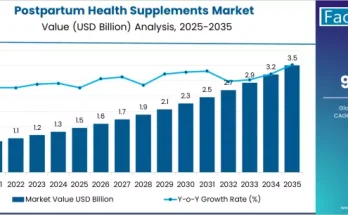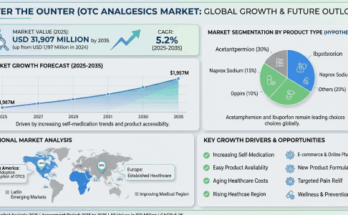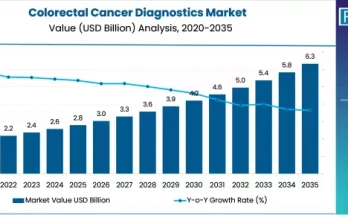The global veterinary antimicrobial susceptibility testing market is poised for robust expansion over the next decade, driven by rising antimicrobial resistance (AMR), adoption of advanced diagnostic solutions, and strengthened regulations promoting responsible antimicrobial use in animals. According to a new analysis by Fact.MR, the market is projected to grow from USD 1.2 billion in 2025 to USD 2.7 billion by 2035, reflecting a strong CAGR of 8.4% and an absolute increase of USD 1.5 billion during the forecast period.
As livestock producers, veterinary hospitals, and diagnostic labs increasingly emphasize accurate antimicrobial selection, AST solutions are becoming indispensable for disease management, productivity enhancement, and AMR prevention.
Strategic Market Drivers
Rising Antimicrobial Resistance (AMR) Elevates Testing Demand
With AMR emerging as a global threat, veterinary practitioners are prioritizing evidence-based antimicrobial usage. AST enables precise drug selection, reduces treatment failures, and minimizes the misuse of critical antibiotics. Growing awareness campaigns and global initiatives—such as One Health—are further accelerating testing adoption across companion and livestock animal segments.
Technological Advancements Strengthen Diagnostic Precision
The market is benefitting from advancements in automated susceptibility testing systems, rapid detection kits, and molecular diagnostic platforms. Automated MIC (Minimum Inhibitory Concentration) analyzers, high-throughput panels, and AI-driven interpretation tools are improving testing accuracy, reducing turnaround time, and supporting early intervention in infectious diseases.
Regulatory Push Toward Responsible Antimicrobial Usage
Stringent guidelines by organizations such as OIE, WHO, and regional authorities are encouraging routine susceptibility testing before prescription. Policies limiting prophylactic antibiotic use are boosting demand for diagnostics to validate treatment necessity and efficacy.
Growing Adoption Across Livestock, Poultry, and Companion Animals
Rising pet ownership, livestock productivity needs, and disease complexity are increasing diagnostic volumes worldwide. Veterinary clinics, diagnostic centers, and animal research institutions are expanding their AST infrastructure to ensure optimal treatment outcomes.
Browse Full Report: https://www.factmr.com/report/veterinary-antimicrobial-susceptibility-testing-market
Regional Growth Highlights
North America: Leading in AMR Surveillance and Veterinary Diagnostics
North America remains a dominant market supported by advanced veterinary healthcare infrastructure, high awareness of AMR, and strong adoption of automated AST systems. The U.S. leads with large-scale integration of diagnostic testing in both companion and production animal segments.
Europe: Strong Regulatory Support and Routine Testing Culture
Europe’s stringent antimicrobial governance and emphasis on laboratory testing are propelling demand. Countries like Germany, the U.K., and France are witnessing increased adoption of standardized AST methods and high investment in diagnostic laboratories.
East Asia: Expanding Livestock Sector and Rising Diagnostic Modernization
China, Japan, and South Korea are key growth hubs owing to intensive livestock farming, rising pet care expenditure, and rapid enhancements in veterinary diagnostics. Government-led AMR control programs are strengthening AST adoption.
Emerging Markets: High Growth Potential
India, Brazil, Southeast Asia, and the Middle East represent significant growth opportunities driven by expanding animal husbandry, improving veterinary care access, and increasing disease surveillance initiatives.
Market Segmentation Insights
By Product Type
- AST Instruments & Systems – Growing adoption of automated platforms.
- Antimicrobial Susceptibility Testing Kits & Panels – Broad usage across labs and clinics.
- Culture Media & Reagents – Strong recurring demand.
- Software & Services – Increasing integration of data analytics and result interpretation tools.
By Animal Type
- Livestock Animals – Highest share driven by cattle, poultry, and swine diagnostics.
- Companion Animals – Fast-growing segment due to rising pet healthcare spending.
By Testing Method
- Disk Diffusion – Widely used for routine diagnostics.
- Broth Dilution & MIC Testing – Preferred for precision testing.
- Automated AST Systems – Rapid adoption for scalability and speed.
- Molecular Methods – Growing relevance in AMR gene detection.
By End User
- Veterinary Diagnostic Laboratories – Largest consumer group.
- Veterinary Hospitals & Clinics – Increasing point-of-care adoption.
- Research & Academic Institutes – Expanding studies on AMR trends.
Challenges Impacting Market Growth
- High Equipment Costs – Advanced systems require significant investment.
- Shortage of Skilled Lab Technicians – Training gaps hinder quality testing.
- Limited Awareness in Emerging Economies – Adoption remains slower in rural settings.
- Complexity in AMR Interpretation – Requires standardized methodologies and guidelines.
Competitive Landscape
The veterinary AST market is moderately consolidated, with leading companies focusing on automated platforms, rapid detection technologies, and broader antimicrobial panels.
Key Companies Profiled:
• Thermo Fisher Scientific
• BioMérieux
• BD (Becton, Dickinson and Company)
• Neogen Corporation
• HiMedia Laboratories
• Merck KGaA
• IDEXX Laboratories
• Bruker Corporation
• Synbiosis
• Liofilchem
Manufacturers are investing in integrated software solutions, rapid molecular assays, and user-friendly automated instruments to enhance diagnostic efficiency and combat global AMR challenges.
Recent Developments
2024: Launch of next-generation automated AST analyzers with AI-based result interpretation.
2023: Expansion of rapid antimicrobial panels for livestock pathogens in North American laboratories.
2022: Increased investment in AMR surveillance programs and molecular detection kits across Europe and Asia.
Future Outlook: A Decade of Precision Veterinary Diagnostics
The coming decade will significantly reshape veterinary antimicrobial testing through innovations in automation, molecular diagnostics, and data-driven AMR surveillance. Companies prioritizing digital diagnostics, integrated software ecosystems, and user-friendly testing platforms will lead market transformation.
With rising global focus on responsible antimicrobial use and animal health optimization, the veterinary antimicrobial susceptibility testing market is set for strong, sustained growth through 2035.



